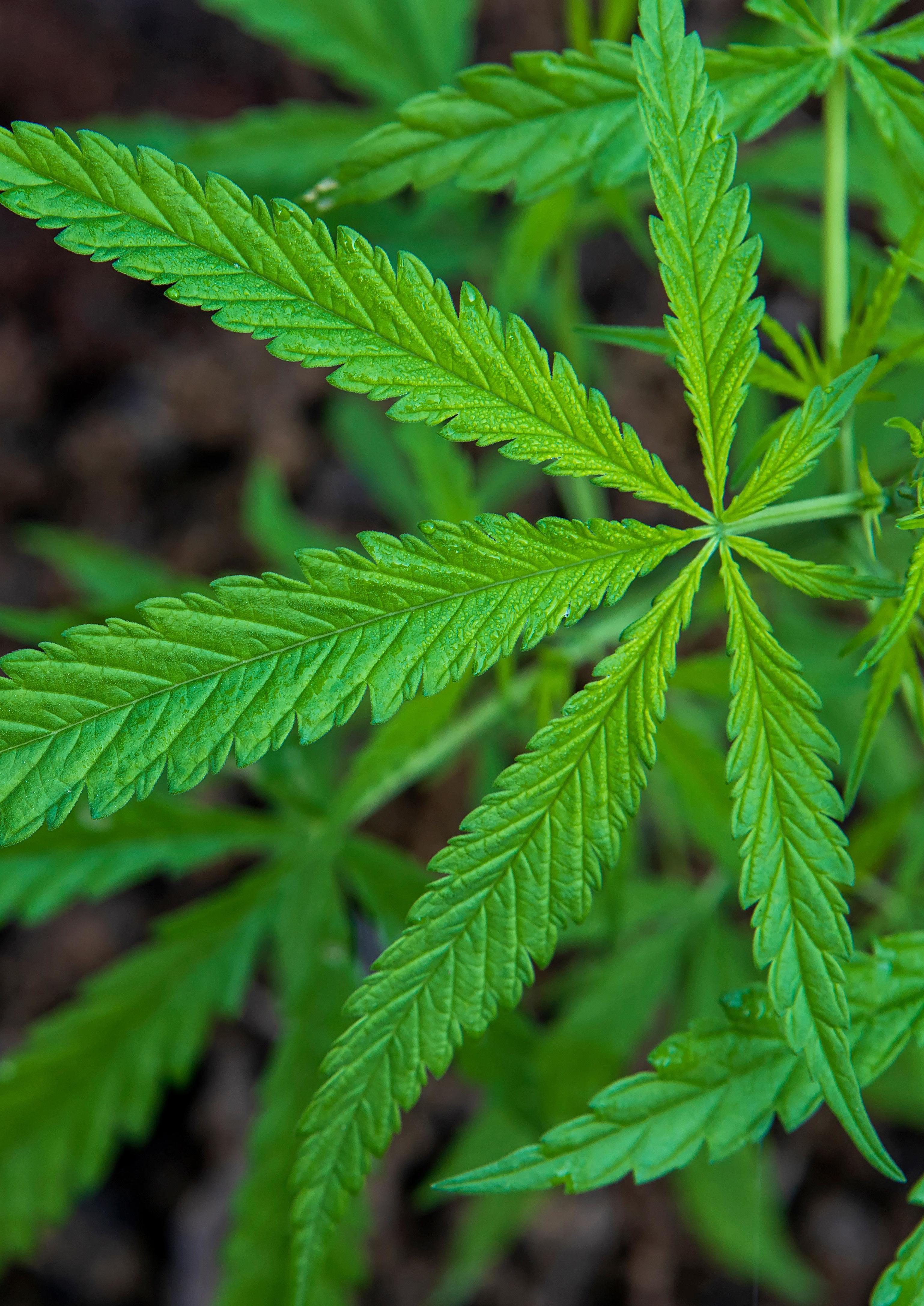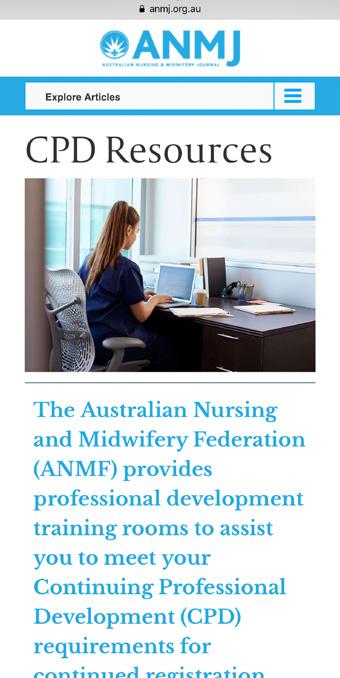
8 minute read
Medicinal cannabis
By ANMF Federal Education Team
As medicinal cannabis products become more readily available to consumers for therapeutic use, nurses and midwives will be involved in the dispensing of the products and monitoring their therapeutic effects.
The following excerpt is from the ANMF’s Medicinal cannabis tutorial on the Continuing Professional Education (CPE) website.
To ensure nurses and midwives have the underpinning knowledge to enter into this practice and to truly understand how medicinal cannabis works, the ANMF is offering this tutorial which is a basic introduction to medicinal cannabis. Cannabis is one of the most investigated therapeutically active substances in history, far exceeding nearly all pharmaceutical agents (Hergenrather et al. 2017). Cannabis has had a long and colourful history. Its use originated in central Asia or western China where it was used for its alleged healing properties for millennia. The first documented use dates back to 2800 BC when it was listed in the Emperor Shen Nung’s pharmacopoeia (regarded as the father of Chinese Medicine) (Lambert Initiative 2019). Medicinal cannabis is currently available in Australia via the Special Access Scheme (SAS) or Authorised Prescriber Scheme. The term ‘medicinal cannabis products’ covers a range of cannabis preparations intended for therapeutic use, including pharmaceutical cannabis preparations such as oils, tinctures and other extracts. The Australian government is facilitating access to medicinal cannabis products to appropriate patients for medical conditions where there is evidence to support its use (Therapeutic Goods Administration, 2018). However, to fully achieve this, several legislative and regulatory changes have been implemented at the Commonwealth level. Additionally, the rules relating to medicinal cannabis products may vary between states and territories and could affect access in those jurisdictions. The Commonwealth developed amendments to the Narcotic Drugs Act 1976 to decriminalise the use and supply of medicinal cannabis (Therapeutic Goods Administration, 2018). The Therapeutic Goods Administration (TGA) in 2017 rescheduled certain medicinal cannabis products to schedule 8 of the Poisons Standard, making the prescription of medicinal cannabis legal in Australia. Victoria was the first state in Australia to introduce legislation to legalise medicinal cannabis, but other states and territories have quickly followed (Canstar, 2017).
WHAT IS CANNABIS AND IS IT THE SAME AS HEMP?
Cannabis is a genus of flowering plant in the family of Cannabaceae. It is indigenous to central Asia and the Indian subcontinent. The number of species within the genus is disputed. Three species may be recognised: 1. Cannabis Sativa 2. Cannabis Indica 3. Cannabis Ruderalis (Wikipedia, 2019) Cannabis, sometimes called marijuana, is a family of plants with two primary classifications Indica and Sativa. While cannabis can be considered a member of either the Indica or Sativa families, Hemp is a member of the cannabis Sativa family. Hemp and cannabis can appear similar, yet each plant has very clear distinctions (Cadena, 2018). Cannabis features broad leaves, dense buds and has a short, bushy appearance. In stark contrast, Hemp features skinny leaves that concentrate towards the top of the plant. Hemp grows taller and leaner than cannabis, with few branches beneath its upper portion. When compared side by side, the two plants can each be clearly identifiable. As we dive deeper into the anatomy of the two plants, each has crucial differences in their chemical composition (Cadena, 2018). Cannabis contains a variety of different compounds called Cannabinoids, two of which, and the most dominant, are Tetrahydrocannabinol (THC) and Cannabidiol (CBD). Both cannabinoids have shown to provide profound benefits to the human body; however, THC induces psychoactive effects (gets the user “high”), while CBD does not contain any psychoactive properties (Cadena, 2018). When comparing Hemp vs cannabis, Hemp contains a very low concentration of THC (0.3% or less), cannabis is abundant in THC with concentrations between 15 to 40%. Because of this, Hemp is grown primarily for industrial purposes, while cannabis is grown for recreational and medicinal purposes (Cadena, 2018). Cannabis produces a variety of compounds known as cannabinoids, many of which have not been detected in any other plant (Leafly, 2019). Cannabis is a complex plant with over 400 chemical entities, of which approximately 140 are cannabinoid compounds. The active ingredients of the cannabis plant fall into three categories: 1. Cannabinoids 2. Terpenes 3. Flavonoids (Entoura Medicinal
Nutrients, 2019) Terpenes and flavonoids help enhance the therapeutic effects of cannabinoids, as well as providing individual health benefits. For example, terpenes have analgesic and/or anti-inflammatory effects, while flavonoids also benefit the immune system. The entourage effect means that many of these compounds work synergistically to enhance the medicinal benefits of cannabis while diminishing the adverse effects, including psychoactivity. Found throughout the brain, nervous systems and organs of humans and all mammals, birds, fish and reptiles, too, the Endocannabinoid System (ECS), is the body’s internal system of cannabis molecules and receptors. Native and primitive, scientists predict that humans evolved to possess this system over 500 million years ago.

The ECS is the largest biological system of receptors in the body, and some scientists believe it is the most important physiological system involved in establishing and maintaining human health. Its job is to maintain homeostasis, or balance, and to keep our cells and immune system healthy (Prima, 2019). Scientists first discovered the ECS while trying to understand the effects of cannabis in humans. While much remains unknown about this system, what is well known is that the human body is full of cannabinoid receptors and produces corresponding molecules which cause the physical and psychological effects of cannabis in our bodies. Since its discovery, the endocannabinoid system has become a prime target of medical research due to its vast effects and therapeutic potential on the human body (Royal Queen Seeds, 2019). In the 1990s, Dr Raphael Mechoulam discovered the endocannabinoid system in his laboratory at the Hebrew University in Israel. Together with his team, Dr Mechoulam uncovered naturally occurring neurotransmitters (called endocannabinoids) that are almost identical in structure to the compounds produced by the cannabis plant (called phytocannabinoids.) From here, active compounds in Hemp and cannabis were uncovered, resulting in the beginning of our understanding of how they impact human health (Prima, 2019). Phytocannabinoids are naturally-occurring cannabinoids found in the hemp and cannabis plants. Science suggests that the most effective way to support our ECS is by ingesting phytocannabinoids. Hemp and cannabis are the only plants in the world that produce cannabinoids (Prima, 2019). There are over 120 known phytocannabinoids in cannabis, and the majority are understudied and not properly understood. Cannabinoids are known antioxidants and neuroprotectants, as proven by the US government’s patent (Patent 6630507B1) stating that “cannabinoids have been found to have antioxidant properties and are found to have particular application as neuroprotectants or in the treatment of neurodegenerative diseases” (Royal Queen Seeds, 2019). The term “endo” is short for endogenous, meaning originating or produced within an organism, tissue or cell. Cannabinoid refers to a group of compounds that activate this particular system (Royal Queen Seeds, 2019). The ECS is made up of two primary cell receptors. CB1 and CB2. The agonists or keys for these receptors are cannabinoids that are produced by the body, as well as cannabinoids that come from outside the body, such as from cannabis (phytocannabinoids) (Royal Queen Seeds, 2019). Imagine cell receptors in the body as a set of locks, each with a set of corresponding keys: chemical molecules called “agonists”. Each time an agonist is bound to a cell receptor, it relays a message, giving the cell an instruction (Royal Queen Seeds, 2019). CB1 receptors are found throughout the human body but mostly exist in the brain and spinal cord. They are concentrated in areas associated with the behaviours, such as in the hypothalamus, which is involved in appetite regulation, and the amygdala which plays a role in memory and emotional processing. They are also found in nerve endings, where they can act to reduce the feeling of pain (Royal Queen Seeds, 2019). CB2 receptors are typically concentrated in immune cells and the peripheral nervous system. When activated, they work to reduce inflammation as an immune response which is primarily believed to play a role in the body’s immune response to diseases and certain medical conditions (Royal Queen Seeds, 2019).
References
Cadena A 2018, Hemp vs marijuana: the difference explained, CBD ORIGIN Entoura Medicinal Nutrients 2019, Booklet on Medicinal Cannabis. Accessed March 2019, entoura.com.au Hergenrather J., 2017 Cannabis consultant, Sebastopol, CA, USA; Presentation for United in Compassion Symposium, Melbourne Australia June 23 – 25, 2017 Lambert Initiative for Cannabinoid Therapeutics 2019, History of cannabis, University of Sydney Leafly, 2019, List of major cannabinoids in cannabis and their effects. Prima, 2019, Meet your endocannabinoid system: The centre of wellbeing. Accessed May 2019, prima. co/guides/meet-yourendocannabinoid-system/ Royal Queen Seeds, 2019. What is the endocannabinoid system and how does it work? Ryan TJ., 2017 Canstar. Accessed March 2019, canstar.com.au/ health-insurance/victorialegalises-medicinal-marijuana/ Therapeutic Goods Administration, 2018; Australian Government Department of Health; Access to Medicinal Cannabis Products. Wikipedia 2019, Cannabis. Accessed 2019 en.wikipedia.org/ wiki/Cannabis
60 MINUTES CPD
The following excerpt is from the ANMF’s Medicinal Cannabis tutorial on the Continuing Professional Education (CPE) website.
The complete tutorial details the following sub topics: History of medicinal cannabis • professional organisation views • detailed information on cannabis and its constituents • different parts and uses • Australian cannabis legislation • medicinal cannabis around the world • Australian medicinal cannabis Special Access Scheme and clinical trials • cannabinoids and the endocannabinoid system • terpenes and flavonoids • the entourage effect, types of cannabis • cannabis products • cannabis consumption • conditions treated with medicinal cannabis • nursing care of the patient using medicinal cannabis • current research and links to external organisations offering many articles on medicinal cannabis. Be sure to add it to your portfolio on the CPE website
To access the complete tutorial, go to
anmf.cliniciansmatrix.com
QNMU, NSWNMA and NT members have access to all learning on the CPE website free as part of their member benefits
For further information, contact the education team at education@anmf.org.au











